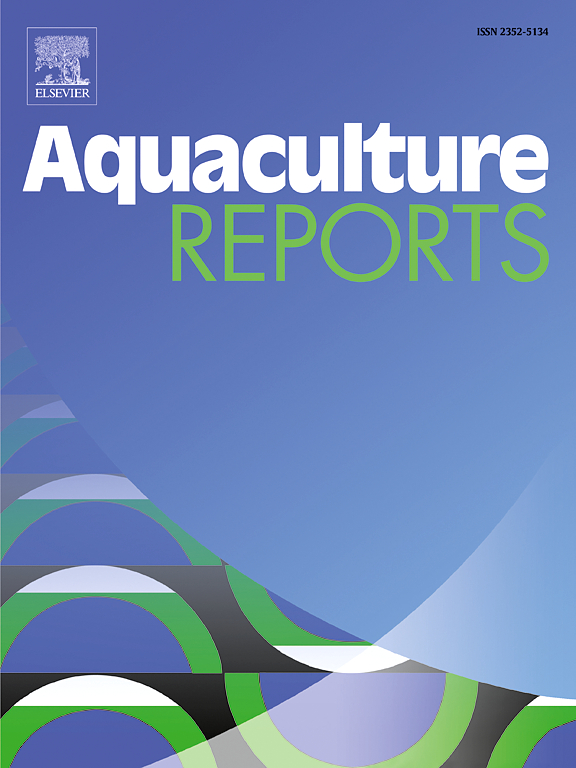Dietary iron oxide (Fe2O3) nanoparticles modulate growth performance, body composition, mineral content and intestinal health of yellow catfish juveniles (Pelteobagrus fulvidraco)
IF 3.2
2区 农林科学
Q1 FISHERIES
引用次数: 0
Abstract
The present study investigated the growth performance, body composition, mineral content and intestinal health of yellow catfish juveniles fed different iron diets and explored the dietary Fe requirements for this fish species. Using iron oxide nanoparticles (Fe2O3 NPs) as the Fe sources, we formulated six experimental diets with dietary Fe levels at 22.23, 28.28, 36.10, 44.53, 52.21, and 61.85 mg Fe/kg diet, respectively. Yellow catfish fed with 44.53 mg Fe/kg diet had the highest growth performance and feed utilization, while those fed 61.85 mg Fe/kg diet showed the lowest growth performance and feed utilization. Dietary Fe addition increased whole-body and intestinal Fe contents. Additionally, the addition of dietary Fe had an impact on whole-body crude protein, crude lipid, ash, calcium (Ca), magnesium (Mg), zinc (Zn), and manganese (Mn) contents, but did not whole-body moisture and copper (Cu) contents. Yellow catfish fed with 44.53 mg Fe/kg diet had an improvement in intestinal histology and an increase in expression of intestinal tight junction-related genes [occludin and tight junction protein 1b (zo-1b)] as well as antioxidant response genes [superoxide dismutase 1 (sod1), sod2 and catalase (cat)], and had higher activities of antioxidant enzymes [CAT, total SOD (T-SOD) and total antioxidant capacity (T-AOC)]. However, malondialdehyde (MDA) content, and gene expression of glucose-regulated protein 78 (grp78), eukaryotic translation initiation factor 2α (eif2α), activating transcription factor 4 (atf4), inositol-requiring enzyme 1 (ire1) (related to endoplasmic reticulum stress), and mRNA levels of tumor necrosis factor α (tnfα), interleukin 1β (il1β), il8 (related to inflammatory response) in the intestine were the lowest in 44.53 mg Fe/kg diet group. Conducting broken-line analysis of weight gain (WG) against dietary Fe levels, we revealed that the optimal Fe requirement was 45.28 mg Fe/kg diet, with Fe2O3 NPs as Fe source.
饲料中氧化铁纳米颗粒对黄颡鱼幼鱼生长性能、体成分、矿物质含量和肠道健康的影响
研究了不同铁饲料对黄颡鱼幼鱼的生长性能、体成分、矿物质含量和肠道健康状况的影响,探讨了黄颡鱼对饲料铁的需求。以氧化铁纳米颗粒(Fe2O3 NPs)为铁源,配制6种试验饲粮,饲粮铁水平分别为22.23、28.28、36.10、44.53、52.21和61.85 mg Fe/kg。饲料中铁含量为44.53 mg /kg的黄颡鱼的生长性能和饲料利用率最高,饲料中铁含量为61.85 mg /kg的黄颡鱼的生长性能和饲料利用率最低。饲粮添加铁可提高全体和肠道铁含量。此外,饲粮中添加铁对全鱼粗蛋白质、粗脂肪、灰分、钙(Ca)、镁(Mg)、锌(Zn)、锰(Mn)含量有影响,但对全鱼水分和铜(Cu)含量无影响。饲粮添加44.53 mg Fe/kg黄颡鱼后,黄颡鱼的肠道组织学得到改善,肠道紧密连接相关基因[occludin和紧密连接蛋白1b (zo-1b)]以及抗氧化反应基因[超氧化物歧化酶1 (sod1)、sod2和过氧化氢酶(cat)]的表达均有所增加,抗氧化酶[cat、总SOD (T-SOD)和总抗氧化能力(T-AOC)]的活性均有所提高。而丙二醛(MDA)含量、葡萄糖调节蛋白78 (grp78)、真核翻译起始因子2α (eif2α)、激活转录因子4 (atf4)、肌醇需要酶1 (ire1)(与内质网应激相关)基因表达以及肿瘤坏死因子α (tnfα)、白细胞介素1β (il1β)、il8(与炎症反应相关)mRNA水平在44.53 mg Fe/kg饲粮组最低。通过对体重增加(WG)与饲粮铁水平的折线分析,我们发现以Fe2O3 NPs为铁源,饲粮铁的最佳需取量为45.28 mg Fe/kg。
本文章由计算机程序翻译,如有差异,请以英文原文为准。
求助全文
约1分钟内获得全文
求助全文
来源期刊

Aquaculture Reports
Agricultural and Biological Sciences-Animal Science and Zoology
CiteScore
5.90
自引率
8.10%
发文量
469
审稿时长
77 days
期刊介绍:
Aquaculture Reports will publish original research papers and reviews documenting outstanding science with a regional context and focus, answering the need for high quality information on novel species, systems and regions in emerging areas of aquaculture research and development, such as integrated multi-trophic aquaculture, urban aquaculture, ornamental, unfed aquaculture, offshore aquaculture and others. Papers having industry research as priority and encompassing product development research or current industry practice are encouraged.
 求助内容:
求助内容: 应助结果提醒方式:
应助结果提醒方式:


